by Alessia Leibert
January 2015
Does working while in school help students succeed in the workforce? Which academic fields have the best outcomes after graduation? Are women and ethnic minorities less at a disadvantage in the job market when they pursue certain majors? In order to answer these questions, we take a close look at the experience of recent post-secondary program completers to find out which combinations of school and work were most successful.
Labor market success has many faces and definitions but some of the most relevant are1:
The dataset includes post-secondary completers from 2008 to 2010 who were 30 years or younger at the time of graduation. Student records were matched with wage data from the Minnesota Unemployment Insurance program from 2005 to 2013, harmonizing the time series to follow each student from three years before graduation to three years after graduation. Covering a seven-year span allows us to capture the effect of early career experience as well as post-graduation work experience.
Research findings can be summarized as follows:
About the DataIncluded in the dataset:
Excluded from the dataset:
|
Educational attainment strongly influences wages and wage growth. Figure 1 illustrates full-time earnings trends from the first to the third year after graduation, corresponding to the important period of career startup for young students. Although undergraduate degree holders started with similar full-time earnings the first year, by the third year Bachelor's degree recipients already had more earning power. Not surprisingly, graduate degrees led to considerably higher starting wages than other educational levels, both because PhD and Master's degree completers were slightly older on average than others (27 at the time of graduation) and because advanced degrees are more selective and can open the door to very lucrative careers.2
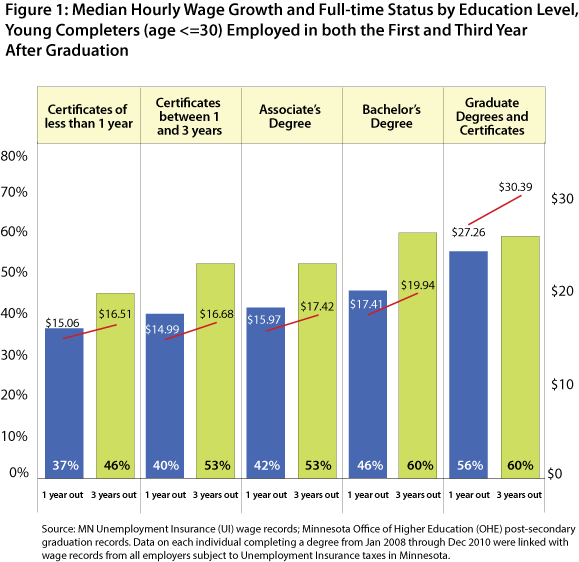
This pattern of higher education level and higher earnings holds across different graduation cohorts, genders, and selected race groups.
Figure 1 also shows the impact of educational attainment on the likelihood of finding full-time employment. As shown by the height of the vertical bars, the share of full-time employment grows consistently by award level, ranging from 37 percent for short-term certificate recipients to 56 percent for graduate degree recipients. The share also increases over time, indicating an improvement in job quality and job stability as individuals spend more time in the labor market.
The pace of growth in full-time employment also depends on economic conditions, which in the time period examined were very weak. The data help us tell the story of the struggle of Bachelor's degree completers in the aftermath of the Great Recession. The first year after college did not go very well. Median hourly wages of $17.41 and full-time employment of 46 percent were only slightly better than 2-year degree completers and show a predominance of occasional and/or part-time employment. Low wages indicate that some had to take jobs for which they were over-qualified. However, the situation improved in the third year, when the share of full-time employment for Bachelor's degree completers jumped to 60 percent, catching up with graduate degree completers. In contrast, those with only a short-term certificate were still predominantly employed part-time three years after finishing school. In other words, the educational advantage helped students get back on a successful path as soon as the economy started to recover in 2010.
Work experience has a strong influence on earnings, especially right after graduation, in the formative years for starting a career. Using seven years of wage data we can identify three distinct patterns of labor market participation:
Wage outcomes differed markedly for these groups as illustrated in Figure 2. The most successful track is the high-intensity one, with an average of 410 hours worked per quarter over seven years. At the same level of educational attainment, the group with prior work experience but low-intensity employment had lower wages than the group with prior work experience at high intensity employment. Median wages prior to graduation were low for all groups, around $10 an hour, until the year before graduation when the trajectories started to diverge. Both Bachelor's and Associate's degree wages for graduates in the high intensity employment pathway started growing much more steeply than their peers in the low-intensity pathway. The smaller group who waited until graduation year to start working had a bit lower wages and flatter earnings than those with the same education but prior work experience.
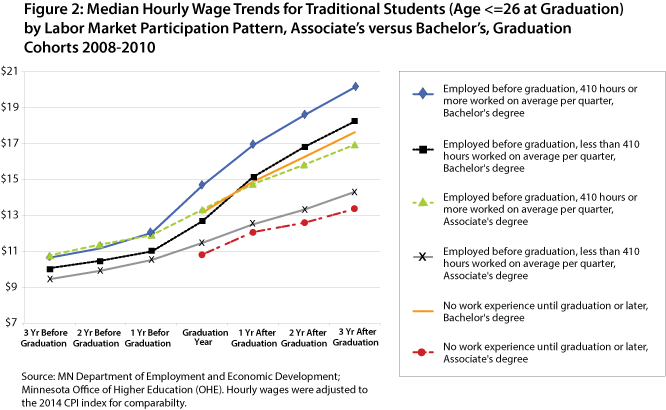
These results suggest that early career employment experience is rewarded in the labor market, and the decision to delay entry into the workforce can put young completers at a disadvantage especially at the sub-baccalaureate level. Late starters have to find a full-time job soon after graduation to make up for the disadvantage of not having worked before.
Does any job experience help increase future earnings prospects? The answer is no. If accumulating hours of work before, during, and after school can be worthwhile, work experience in an industry related to one's field of study is even more valuable. Some employers value industry-related experience even more than formal educational credentials. Table 1 compares wages pre- and post-graduation for individuals who had tenure in a related industry versus those who had shorter or no industry tenure.
| Impact of Training-related Work Experience on Earnings, Certificates and Degrees of More than 1 but Less than 4 Years, Graduation Years 2008-2010 | |||||
|---|---|---|---|---|---|
| ACADEMIC PROGRAM | Industry of Employment 2 Years Before graduation | Median Wage 2 Years Before Graduation | Industry of Employment 3 Years After Graduation | Median Wage 3 Years After Graduation | Percent Wage Growth |
| Health Professions and Related (Registered Nursing, Practical and Vocational Nursing, Nursing Assistants, Health and Medical Assisting Services) | Healthcare and Social Assistance | $13.39 | Healthcare and Social Assistance | $22.75 | 70% |
| Outside Healthcare and Social Assistance | $14.93 | 12% | |||
| Outside Healthcare and Social Assistance | $10.62 | Healthcare and Social Assistance | $18.50 | 74% | |
| Outside Healthcare and Social Assistance | $13.60 | 28% | |||
| Construction Trades (Electrical and Power Transmission Installers,Plumbing, Carpentry) | Construction and Utilities | $12.92 | Construction and Utilities | $21.03 | 63% |
| Outside Construction and Utilities | $17.02 | 32% | |||
| Outside Construction and Utilities | $10.46 | Construction and Utilities | $18.78 | 80% | |
| Outside Construction and Utilities | $15.67 | 50% | |||
| Precision Production (Welding, CNC Machining, Sheet Metal Working) | Manufacturing | $12.88 | Manufacturing | $19.50 | 63% |
| Outside Manufacturing | $17.59 | 47% | |||
| Outside Manufacturing | $9.95 | Manufacturing | $18.25 | 83% | |
| Outside Manufacturing | $17.21 | 72% | |||
| Sources: MN Department of Employment and Economic Development; Minnesota Office of Higher Education (OHE). Hourly wages from previous years were adjusted to the 2014 CPI index for comparability. | |||||
In all three academic fields in Table 1 the highest wages and the largest wage growth three years after graduation were achieved by completers who managed to break into an industry sector strongly related to their field of study. This is a key characteristic of successful paths into the labor market.
Industry of employment prior to graduation contributed to wage gains everywhere, but especially in Health Professions and Related programs where graduates with prior work experience in Healthcare and Social Assistance reached an hourly rate of $22.75 representing 70 percent wage growth.
What about those who did not find a job in a related industry? The consequences of taking this path were particularly damaging for Health Professions and Related programs graduates. Those who always worked outside the Healthcare industry in the six-year period ended up with a median wage of only $13.60 three years after graduation, representing just 28 percent more than they were making two years before graduation. This path led to under-utilization of skills or work in job roles that were probably not aligned with the training received.
The losses for working outside a related industry were more modest for completers in Construction Trades and Precision Manufacturing, mainly because construction-related and welding job opportunities can also be found outside Construction, Utilities, and Manufacturing. Still, the results confirm that accumulating tenure in a related industry, even if not with the same firm, for a year or more is quite substantially rewarded.
The success that students have in the labor market often varies by gender. One reason is that the commitment to work, or full-time work, has traditionally been lower for women from competing family responsibilities. This might give men more time to accumulate work experience and distort wage comparisons to women. In order to reduce bias we will compare wages for full-time employees only.
As shown in Figure 3, women who were working full-time still earned less than men.
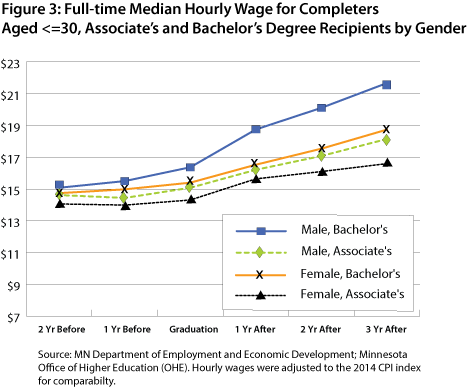
Do these results mean women were paid less than men with the same educational level? A closer look tells a more complex and encouraging story. Figure 4 displays the largest majors with gender imbalances, comparing females' and males' third year full-time earnings. Wage gaps almost disappeared in most majors like Communication and Journalism, Biology, Psychology, and IT. Women actually earned more than males in Engineering and in Health Professions and Related programs.

Education is the only female-dominant major where large wage gaps persisted. Women earned an hourly median that was $3 less than males. Even women who were employed in the education sector were paid less than males overall.
In conclusion, overwhelming evidence proves that women have the ability to perform just as well as men who majored in the same academic fields. But women have been historically less likely to enroll in the highest paying majors such as Engineering, IT, and Finance.
The impact of race on employment outcomes is very complex to analyze and interpret, primarily because race and ethnicity groups are very heterogeneous and differ from one another, with characteristics that are hard to measure. For example, age of award completion differed markedly across groups. Black/African American and Native American students completed a sub-baccalaureate award at the average age of 31, compared to white and Asian students who completed at the average age of 27 and 26 respectively. Minority students, except for Asians, were more likely than white students to wait a few years after high-school before enrolling in a post-secondary program.
Moreover, an educational achievement gap is apparent in the higher concentration of African American and Hispanic completers in sub-baccalaureate programs compared to white and Asian students. Almost 70 percent of white and Asian students in the time period examined obtained a Bachelor's or higher as their terminal degree, compared to 52 and 56 percent for Black/African American and Hispanics respectively (see Table 2). The Non-resident Alien's category, which, at 43.3 percent, had the highest educational attainment, represents foreign-born students with valid Social Security Numbers who came to Minnesota to attend a four-year college or professional school predominantly in Business and IT. They are excluded from this analysis.
| Post-secondary Completers Aged <=30 Who Were Employed in Minnesota the Third Year After Graduation by Race/Ethnicity, Graduation Years 2008-2010 | ||||||
|---|---|---|---|---|---|---|
| White | Asian | Black/ African American | Hispanic /Latino | Non-resident Alien | Other, Non- white* | |
| All Graduates, Percent | 86% | 5% | 3% | 2% | 2.4% | 2% |
| All Graduates, Number | 109,154 | 5,822 | 3,957 | 2,650 | 3,042 | 2,363 |
| By Education Level | ||||||
| Certificates of Less than 2 Years | 9.1% | 10.3% | 19.9% | 14.5% | 0% | 16.7% |
| Associate's Degree | 23.4% | 20.5% | 27.8% | 29.7% | 5% | 38.2% |
| Bachelor's Degree | 54.8% | 55.9% | 43.3% | 45.4% | 51.6% | 39.0% |
| Graduate Degrees and Certificates | 12.6% | 13.4% | 9.0% | 10.4% | 43.3% | 6.0% |
| 100% | 100% | 100% | 100% | 100% | 100% | |
| *This category includes the following small race/ethnicity groups: American Indian or Alaska Native, Native Hawaiian or Other Pacific Islander, Two or More Races. Four percent of students did not report their race or ethnicity and were excluded from the analysis. | ||||||
| Source: Minnesota Office of Higher Education (OHE). | ||||||
Just as we did for gender, we will look at earnings by race/ethnicity for full-time employees only, limiting the comparison to Associate's and Bachelor's degree completers (see Figure 5).
Black/African American Associate's degree completers who were employed full-time during the seven year period performed very well in the labor market. Their median wages prior to graduation were higher than those of white students overall because they were older at enrollment, but white students caught up with them one year after graduation.
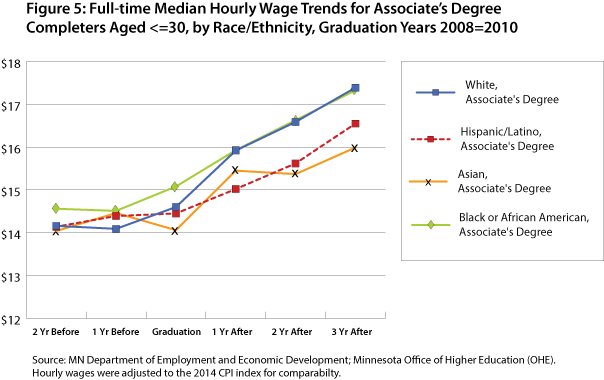
Hispanic students started with low full-time wages ($14.14 an hour) and ended at $16.55 six years later. The wage progression of Asian students is bumpy because of small numbers in this group and less successful than others in terms of wage growth.
Wages for white Bachelor's degree cohorts followed almost exactly the same trend as white Associate's degree cohorts. Their track is markedly different from other race groups (see Figure 6). It starts lowest because of the younger age of enrollment, climbs rapidly the first year after graduation, and then surpasses all other groups.
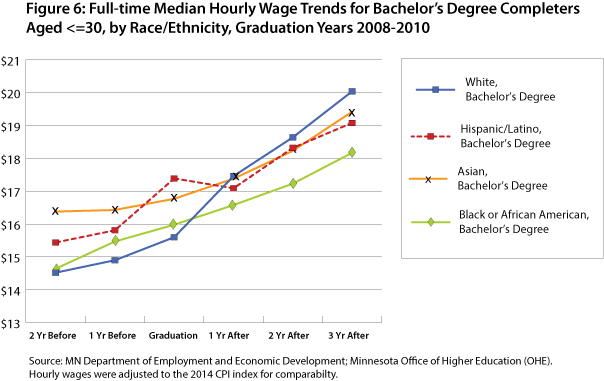
We also observe that the Hispanic and Asian Bachelor's cohorts significantly out-earned the Associate's cohorts. Education level is probably not the only reason for such differences. Since these racial groups are very heterogeneous in terms of socio-economic characteristics and time of migration to the U.S., it is not surprising to find a high-performing and a low-performing group.
Did wage disparities persist within the same major? For the most part, selecting a high earning major helped ethnic minorities reduce the wage gap. However, choice of major does not provide as good an explanation for race-based wage gaps as it did for gender-based wage gaps. Although white and Asian Bachelor's completers were slightly more likely to choose high-earning fields like IT, Engineering, and Business, right after graduation their wages were already higher than Black/African American graduates who majored in these same academic fields. And full-time wages for white students grew faster than full-time wages for Black/African American students with the same major, so that by the third year whites with an Engineering degree earned $2/hr. more, those with a Business degree $3.68/hr. more, and those with an IT degree $4.32/hr. more than Black/African American full-time employees with the same educational background. Further research is needed to understand the reasons why the labor market experiences of some minority students differed so much from their white counterparts.
Choice of major is one of the most consequential in one's life and strongly determines the payoffs from higher education. In general, technical and occupation-oriented certificates and degrees tend to have a higher return on investment than non-technical degrees, at least in the short-term, because they prepare for work in specific careers. However, even students who choose technical/occupational majors could land on very different paths depending on job availability in the occupations for which the specific major prepares them.
Figure 7 looks at the effect of major on earnings, employability, and full-time status. We chose four academic fields which led students to dramatically different outcomes three years after graduation.
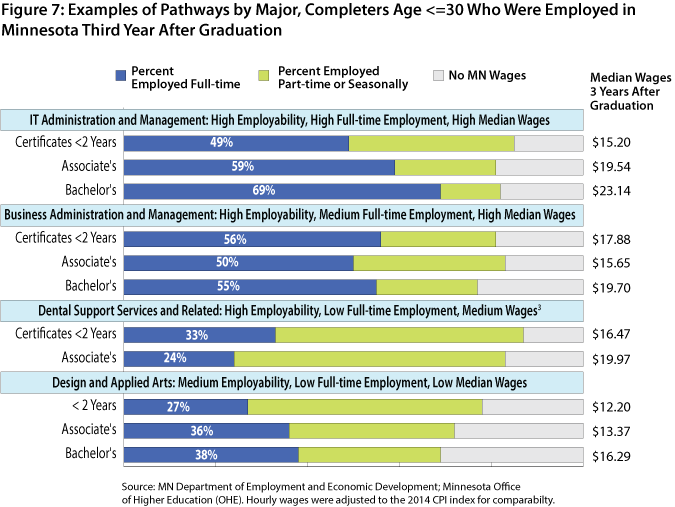
Earnings are the only outcome that grew consistently with education level, with the exception of Certificates in Business Administration which paid more than Associate's in the same field. But earnings varied even more by major. An Associate's degree in IT paid almost as much as Bachelor's degrees in Business Administration and Dental Support Services.
Employability was typically highest for certificate holders, ranging from 85 percent in IT Administration and Management to 78 percent in Design and Applied Arts. This is great news for individuals who do not want to commit to college. However, high job availability does not necessarily translate into job quality and good wages if the available jobs are predominantly part-time like those for Dental Support Services and Design and Applied Arts. Full-time employment in these majors was less than 50 percent at every education level.
In contrast, people who majored in IT and Business Administration were highly employable and also had much higher full-time employment at all education levels. Higher shares of full-time employment typically go hand in hand with higher wages. When there are more graduates than positions to fill, jobs might be available there but with low hours and wages.
Choice of major is a key factor in determining the experience of a young graduate in terms of employability, wages, and job quality prospects because it prepares students for occupations that may be in high or low demand. The results above underscore the importance of early career exploration for students who want to pursue post-secondary education.
There are many pathways into the labor market. Our research discovered that some pay off more than others, and there are practical steps students can take to make the most out of their educational investment. Specifically:
Choice of major is particularly critical for females and minority students as a way of overcoming, at least partially, the disadvantages that they face in the labor market.
Initiatives aimed at improving students choices, for example, by providing timely information on in-demand careers and growing industries, can go a long way to contribute to the alignment of workforce skills with the needs of Minnesota employers.
1Measuring job satisfaction and self-fulfillment, also among the most important outcomes of a post-secondary education, is beyond the scope of this purely quantitative analysis.
2Individuals who obtain these degrees probably differ from others in unobservable characteristics such as abilities, motivation, and family background which can have a considerable impact on earning power.
3Insufficient bachelor's records to draw meaningful conclusions.